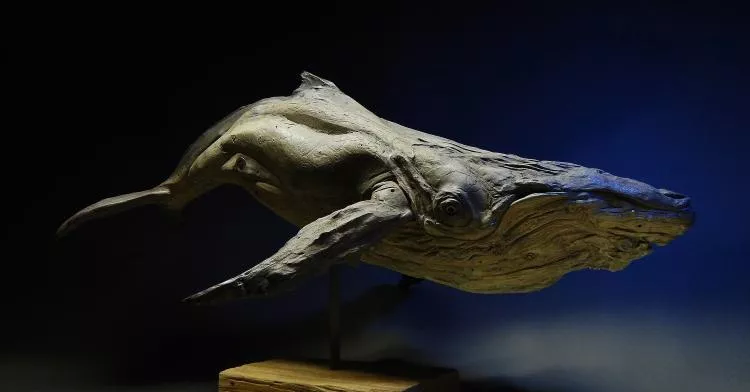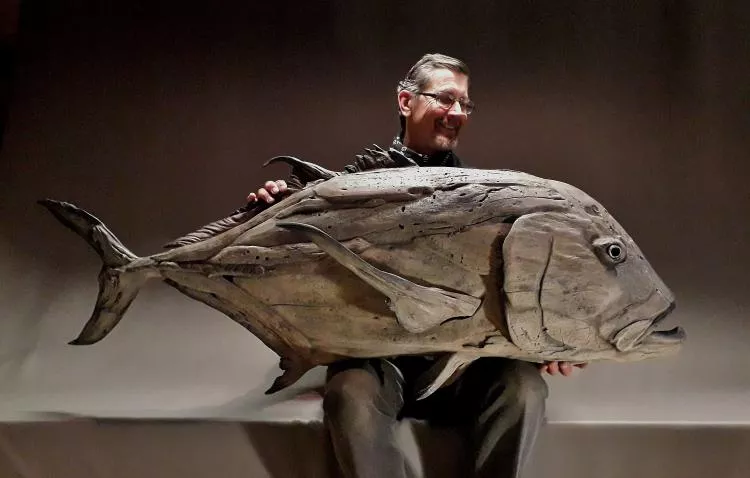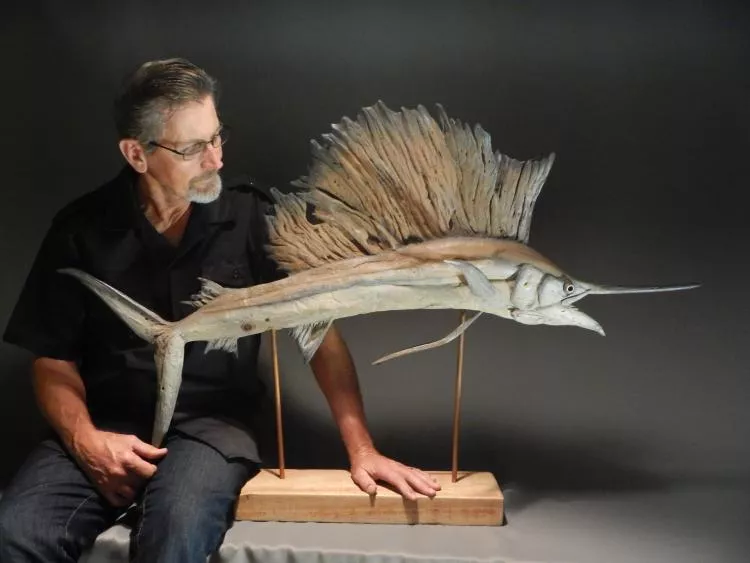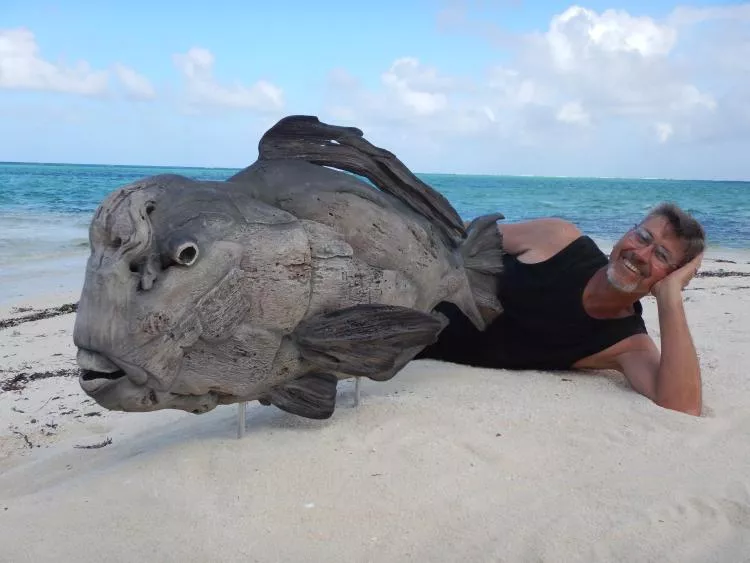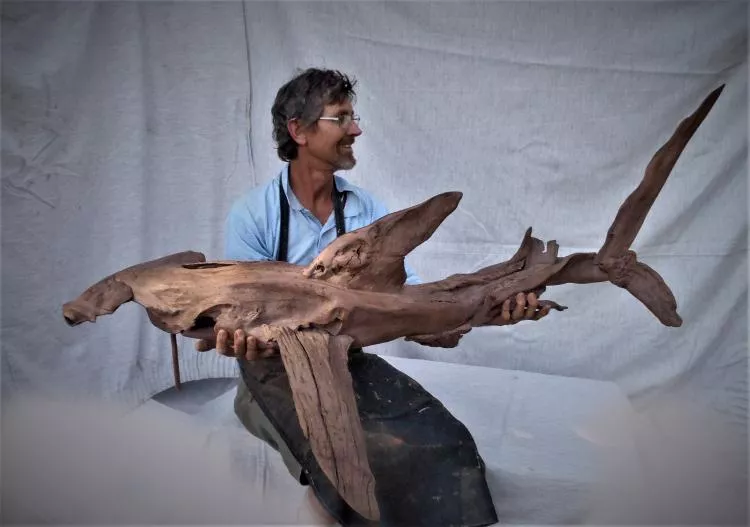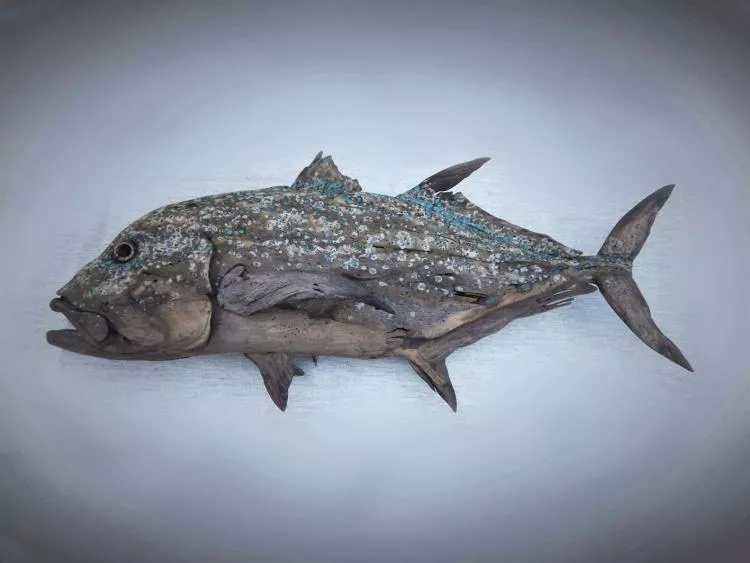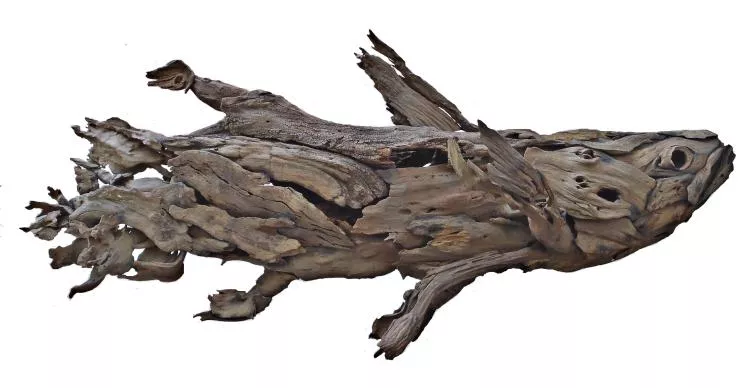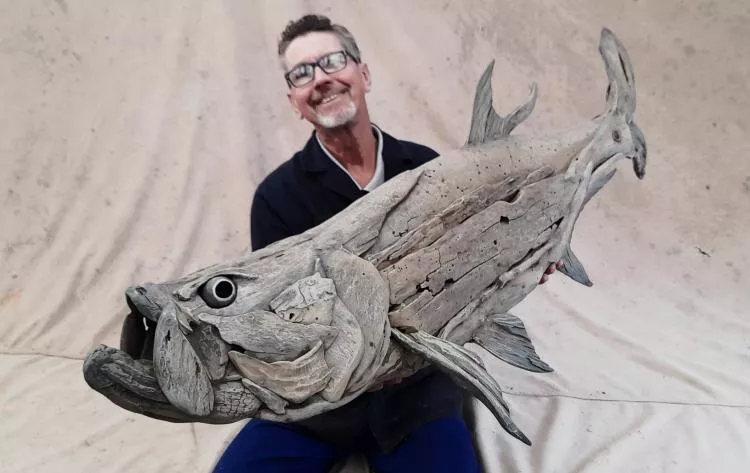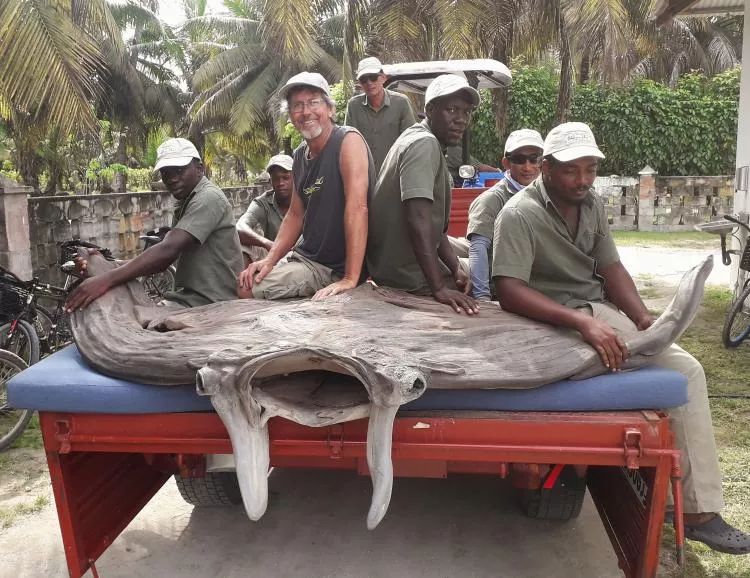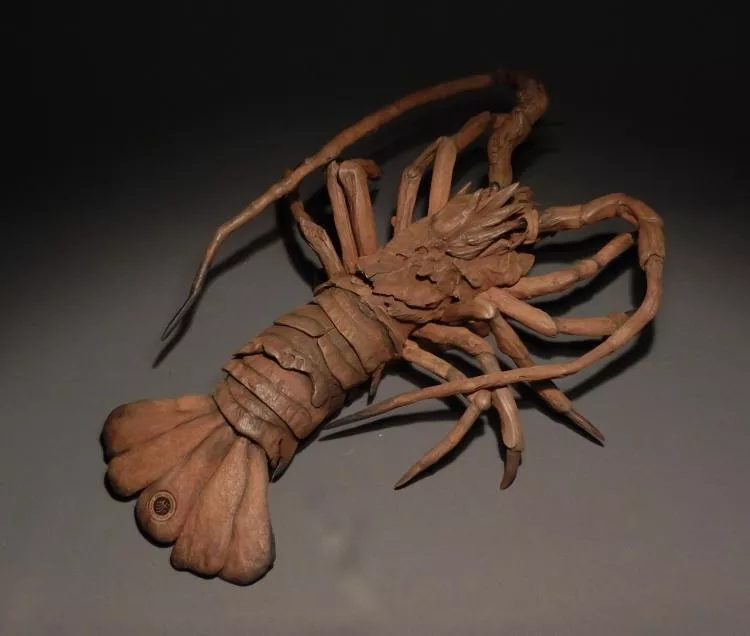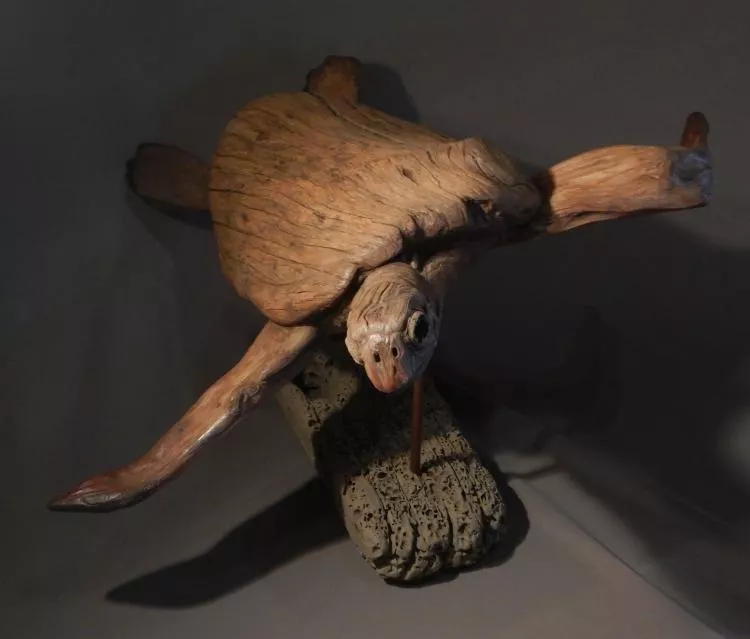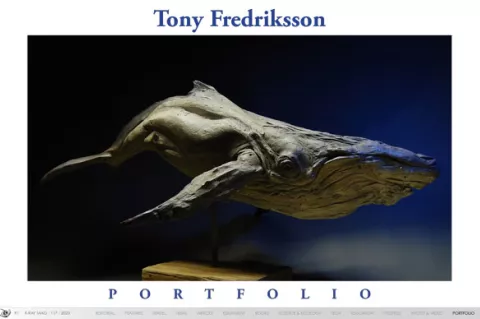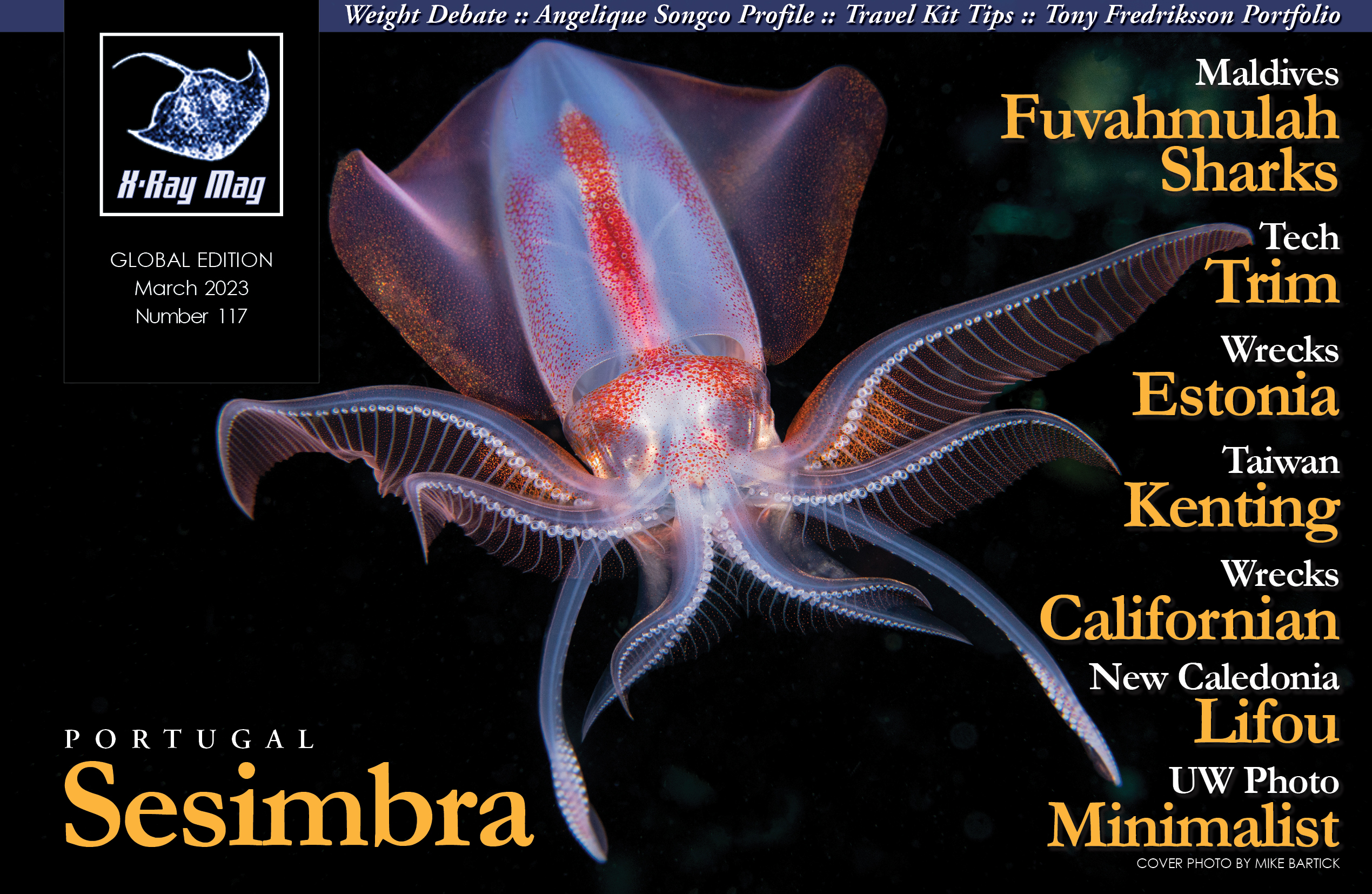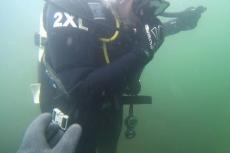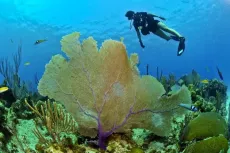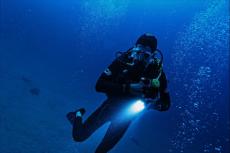Originally from Zimbabwe, artist Tony Fredriksson is a sculptor based in South Africa who creates incredibly life-like sculptures of marine life out of driftwood, drawing inspiration from how the wood is eroded by weather, scoured by streams or sanded smooth by sand. X-Ray Mag interviewed the artist to learn more about his artworks and creative process.
Contributed by
X-RAY MAG: Tell us about yourself, your background and how you became an artist.
TF: We are all born with different gifts, mine is art. I was born and grew up in Rhodesia (present-day Zimbabwe). At six years old, my parents gave me plasticine, so modelling and sculpting became my favourite pastime. I studied art and went into the commercial world of graphics for the printing industry doing lithography and photography. I have enjoyed almost every form of art: painting, drawing, architecture, sculpting in different mediums, and photography.
In this time, I also did numerous fish drawings and a fishing-related cartoon for fishing magazines. During the 1980s, my brother and I started a fish taxidermy business but with a difference. We made sculptures of their trophy fish to encourage anglers to catch and release.
My gift was also used to start a small business producing small sculptures of animals, pets and insects which lasted about 12 years, combined with making rustic furniture.
Do we associate “becoming something” only when what we do is exchanged for income? I think there are millions of artists who don’t make a living from their art but are forced to earn a living through other means.
X-RAY MAG: How and why did you choose driftwood as a material for your sculptures? What are the challenges, advantages and joys of working with driftwood?
TF: Eccl. 9:11 says: “I have seen something else under the sun: The race is not to the swift or the battle to the strong, nor does food come to the wise or wealth to the brilliant or favour to the learned; but time and chance happen to them all.”
I picked up a piece of weathered wood from a wildlife rehabilitation enclosure and turned it into a sculpture of a lionfish (2010). A gallery owner saw the sculpture and invited me to have a solo exhibition of driftwood fish. My first solo exhibition of fish sculptures sold out that year and hence became the start of the driftwood sculptures.
Time is the greatest challenge, collecting the raw material, looking for that perfect part, then sorting the pieces to connect them into the chosen subject.
The big advantage is that your building material becomes your armature which can also be exposed on the surface. Because the driftwood has endless shapes and textures, it becomes mind-boggling when you see a variety of possibilities for each piece. The predicament is to decide how to use the material. I find limitless potential in the material. I find joy in the treasure hunt that ends in a sculpture using part of creation to create something that resembles creation.
X-RAY MAG: We realise you create sculptures of many kinds of species on land and in the sea, but what fascinates you most about marine life in particular? How does driftwood lend itself as a material in the sculpture of marine life?
TF: Seventy-one percent of the earth is covered by oceans and lakes, filled with 21,000+ colourful and diverse fish species. I come from a family of generations of fishermen, so fish has always been an obsession with us. I even did illustrations for books on fish and screenprints of them, bred and farmed with them. Fish tanks and garden ponds have always been part of our lives. It was easy to collect driftwood in rivers or on the coast when exploring these places.
The reason many of my commissions are for marine life is due to the fly-fishing fraternity’s conservation ethics. They can catch-and-release and still continually enjoy “their catch.”
X-RAY MAG: Who or what has inspired you and your artwork and why?
TF: I can’t say that I have been influenced by a mentor, but I do get inspired by other artists’ work. All my inspiration comes from Creation itself; everything is fearfully and wonderfully made. Just the study of anatomy with each subject can be enthralling, what’s beneath the surface, how we are put together.
My inspiration comes from the wood itself, after a tree dies, it may have been eroded by the weather, then washed down a stream and finally sanded smooth by the sand on a beach. It is continually changing shape.
X-RAY MAG: What is your artistic method or creative process?
TF: Once I find a piece that resembles a part of the subject, I draw out a rough design of the subject from this piece and then start searching for all the other parts. I collect images of the subject from all angles and use these as a reference to get the proportions and pose correct. The important step is to join them securely with wood glue and screws which I cover up. It is an advantage to use the same-looking wood so that the artwork has a uniform finish. The final artwork is frozen to make sure there are no bugs in the wood.
X-RAY MAG: What is your relationship to the underwater world and coral reefs? How have your experiences underwater influenced your art? In your relationship with reefs and the sea, where have you had your favourite experiences?
TF: I have been blessed to be able to experience Alphonse Island and Farquhar Atoll Islands in the Seychelles whilst there making fish sculptures for the Blue Safari Lodges. Snorkelling on these reefs and seeing first-hand the fish that I had illustrated or studied in numerous books was worth remembering. I am always blown away by the different shapes and colours of the reef fishes. No illustration or painting can do their true underwater colours justice.
During 2022, my son and I were able to flyfish for the humphead parrotfish on Farquhar Atoll. The resort had a skull of a humphead that looked almost like a sheep skull, which amazed me, as it resembled a sheep skull. The fish even seemed to graze together on the coral at high tide like sheep. I had done an oil painting of one and wished to actually see one close-up at the time. We both managed to hook them, gently hold, photograph and examine them before releasing them back into the “herd” where they continued to feed as if nothing had happened.
X-RAY MAG: What are your thoughts on ocean conservation and how does your artwork relate to these issues?
TF: I have seen the extent of the pollution in various beaches and inland waterways but have not yet made any artwork for ocean conservation, only annual artworks of rhinos that have been auctioned towards their survival. But just the fact that a fish can be released because there is a way to commemorate the catch with a sculpture, contributes to conservation. I know the prohibition on travel and activities of trawlers during [the pandemic] lockdown did improve fish numbers in our African waters, but I am not an expert in this matter.
None of the wood used in my sculptures has been harvested from living trees, and hardly anything unnatural is used, except for a few screws and glue. I do, however, get some orders for castings of the sculptures in bronze or marble composite.
X-RAY MAG: What is the message or experience you want viewers of your artwork to have or understand?
TF: There is no message in the sculptures; they are simply representations of the Lord’s creatures, both great and small, to bring enjoyment to others. I love to make mechanical subjects too, musical instruments and motor vehicles, which celebrate humankind’s ingenuity.
X-RAY MAG: What are the challenges or benefits of being an artist in the world today? Any thoughts or advice for aspiring artists in ocean arts?
TF: For me, the greatest benefit today is the easy access to reference material on the web and how easy selling has become online. I still sell art through galleries and enjoy face-to-face interaction in that environment. Social media allows everyone to connect, so we can have more interaction with people from around the world.
You never know what will succeed, so keep as many doors open for business and diversify. I have seen artists saturate a geographic area with their art until the public finds a new trend. If the artists do not come up with something new, they will struggle. Artists should always challenge themselves to learn a new skill or try a different medium and be flexible.
X-RAY MAG: How do people respond to your artworks?
TF: It is always rewarding to see first-hand reactions to one’s work—fascination, wonder and even amazement—in a gallery. At a private school where I had my Gorilla sculpture on display, I watched a dog became frantic when noticing the Gorilla. At a client’s home, I watched as their cat’s hair stood up and it cautiously crept around my Serval Cat sculpture.
Probably the most amazing incident was with my life-size Masai Warrior sculpture in a private home, which was burgled. There was a shootout with a security company, and the sculpture was shot in the leg during the skirmish, as it was mistaken for a person. I offered to repair it, but the clients wanted the “wounded” sculpture as a memento.
X-RAY MAG: What are your upcoming projects, art courses or events?
TF: I do try to do at least one exhibition or group show a year. I have been invited to participate in a show with artists who do recycling art during March this year. Otherwise, my time is limited with commissions each year and I don’t have time for courses or other events.
X-RAY MAG: Lastly, is there anything else you would like to tell our readers about yourself and your artwork?
TF: The Bible says we were made in God’s image. Therefore, like God who created you and me could make this amazing world and universe, we all have creativity within us. I have seen this in children who use their imaginations for games, stories and play. Sadly, we seem to lose some of this as we age. We should never stop playing and imagining but continually cultivate our senses to find wonder in every day.
I pray for help with each artwork to be able to capture just a small part of the beauty and wonder of God’s handy work in my sculpture. Don’t bury your gift. ■
For more information or to purchase artwork, please visit the artist’s website at openskywoodart.com or on Instagram @ tonyfredriksson_ or Facebook @ Tony Fredriksson Driftwood Sculptures.

